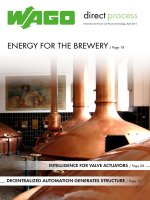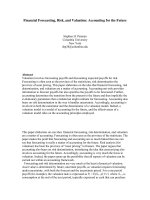ENERGY FOR THE BREWERY potx
Bạn đang xem bản rút gọn của tài liệu. Xem và tải ngay bản đầy đủ của tài liệu tại đây (3.59 MB, 24 trang )
ENERGY FOR THE BREWERY /
Page 18
direct
process
Information for Power and Process Technology, April 2013
INTELLIGENCE FOR VALVE ACTUATORS
/ Page 08
DECENTRALIZED AUTOMATION GENERATES STRUCTURE / Page 12
2
NEW SWITCHING SYSTEMS PROVIDE A SECURE SUPPLY IN THE LONG TERM
Page 04
TELECONTROLLER AS ECO VERSION Page 06
THAT CERTAIN EX-TRA IN EX-I: NEW INTRINSICALLY SAFE MODULES FOR THE
WAGO-I/O-SYSTEM Page 07
INTELLIGENCE FOR VALVE ACTUATORS
Page 08
DECENTRALIZED AUTOMATION GENERATES STRUCTURE
Page 12
PUMPING STATION
Page 15
ENERGY FOR THE BREWERY
Page 18
WATER MANAGEMENT IN THE INTERNET
Page 22
IMPRINT Page 24
CONTENTS
NEW SWITCHING SYSTEMS PROVIDE A SECURE
SUPPLY IN THE LONG TERM / Page 04
3
direct process
Dear Readers,
Modular automation concepts, in the sense of
the “F3 Factory” EU research project, were the
focal point of our last WAGOdirect process.
The modularization of machines, systems or
entire facilities remains relevant, and it fits hand
in glove with an increasing decentralization:
Intelligent control moves from a high automation
level down to the field level and thus ever closer
to the process. The hardware used there must
primarily fulfill two prerequisites: On the one
hand, it has to be powerful enough that all auto-
mation technological demands can be met. On
the other, it should be independent of manufac-
turer and protocol, so that it can be seamlessly
integrated into a modular system.
Both of these factors were decisive, when
Zauner Automation decided to use the WAGO-
I/O-SYSTEM 750. The specialists in automated
valves and position actuators used it to develop
a standardized electrohydraulic control unit that
is used, among other places, for 24-inch valve
automation on natural gas platforms. Another
application, in which decentralized automa-
tion plays a decisive role, is the wastewater
treatment facility in Rinteln. Among other tasks,
the WAGO-I/O-SYSTEM forms the interface
between various systems and measurement
concepts in the process technology.
You will find these and other successfully
completed projects from recent months in your
current issue of our WAGOdirect process. Enjoy
the articles!
Best regards,
Wolfgang Laufmann
Market Management Industry & Process
Chemistry
CONTENTS EDITORIAL
4
■
To ensure the power supply at Volkswagen’s Wolfsburg facility,
between 2005 and 2015, VW Kraftwerk GmbH will be modern-
izing the 110 kV, 20kV, and 6kV power networks.
During this
process, the switching systems will be replaced one after another.
As part of the system renovation, VW Kraftwerk decided to use
maintenance-free spring-clamp terminal blocks rather than screw-
clamp terminal blocks.
VW Kraftwerk GmbH is a 100% subsidiary of Volkswagen AG.
It is a service provider for the Volkswagen group, as well as for
communities, industry, and commerce in the areas of power sup-
ply, trading, power plant planning, and facility management.
Both the north/south and west heating plants, operated by Volk-
swagen AG at its Wolfsburg location, supply power and heat
to Volkswagen AG’s headquarters (Wolfsburg plant). They also
supply the city of Wolfsburg with heat. Some of VW Kraftwerk’s
equipment was more than 45 years old. During the moderniza-
tion, the company focused on ensuring that the replacement and
retrofitting were associated with cost advantages as well as ac-
tively contributing to environmental protection in the interest of
sustainability. In relation to the switching systems, the moderniza-
tion of the electrical network in 2010 was the largest part of the
renovation. By the end of 2015, VW Kraftwerk GmbH will have
replaced a total of 23 switching systems. After completing all of
the work, 90% of the electrical connections will have been con-
verted to maintenance-free spring-clamp terminal blocks.
■
Spring-Clamp Terminal Blocks Win Over Planners
The first project began in 2005 with the rebuilding of a 6.3 kV
in-house switching system at the power plant. Criteria such as
technical safety and return on investment played a large role in
the selection of the new terminal blocks. WAGO’s disconnect
terminal blocks are constructed so that there can be no improper
operation by the user. Every conductor makes contact via its own
clamping point. Furthermore, they are touch-proof, easy to han-
dle, and maintenance-free. Aside from system-dictated contact
terminal blocks, only WAGO terminal blocks were used for this
project.
NEW SWITCHING SYSTEMS
PROVIDE A SECURE SUPPLY
IN THE LONG TERM
5
direct process
■
Many Types of Rail-Mounted Terminal Blocks
The responsible department was especially interested in
WAGO’s 280 and 282 Series disconnect terminal blocks for test
and measurement. The 282 Series disconnect terminal blocks
make contact regardless of the user, which prevents misuse.“
Accurate handling is very important to us, especially for work on
current transformer terminal blocks that does not occur on a daily
basis,” confirms Wolf. Only one switch lever must be manually
shifted to create the desired electrical connection to the adja-
cent terminal blocks, in order to short current transformers, for
example. Integrated insulated test sockets also facilitate the direct
connection of a measuring device.
Large variety of spring-clamp terminal
blocks, including TOBJOB
®
S
Safe and maintenance-free connection
technology
8-level terminal blocks for matrix patch-
ing facilitate rewiring and measuring of
individual signals.
6
For through connections, both TOPJOB
®
S rail-mounted terminal
blocks and 285 Series high-current rail-mounted terminal blocks
are used. TOPJOB
®
S rail-mounted terminal blocks are equipped
with CAGE CLAMP
®
S Spring Pressure Connection Technology,
providing push-in termination of solid or ferruled conductors.
The terminal blocks accommodate conductors ranging from
0.25 mm
2
(AWG 22) to 16 mm
2
(AWG 6). For larger cross-
sections, both engineering department and suppliers selected
WAGO’s 285 Series high-current through terminal blocks. They
accommodate conductor sizes ranging from 6 to 95 mm
2
(AWG
10–4/0) A locking tab holds the clamping unit open for terminal
blocks with POWER CAGE CLAMP connection. In this way, the
user has both hands free to position the conductor end properly.
An additional patchboard level is located between the field and
automation level. 727 Series 8-level terminal blocks for matrix
patching replace the soldering strips from the earlier system. The
terminal blocks for matrix patching facilitate rewiring and measur-
ing of individual signals. As neutral transfer points, they increase
the flexibility of the system. The allocation of the signal lines can
be quickly determined via terminal block markers.
Text: Renate Klebe-Klingemann, WAGO
Photo: VW Kraftwerk GmbH, WAGO
■
Economical alternative: WAGO’s 750-880/025-002 ECO Tele-
controller offers unlimited application potential in a limited number
of modules
Unlike the regular 750-880-025-001 Telecontroller: The new
750-880/025-002 ECO version is limited to a maximum number
of four modules (without end module), and is therefore around one-
third less expensive. This is a cost-saving alternative for customers
with smaller applications (e.g., transformer station or local network
station monitoring, EEG plant power reduction, virtual power plant
control). Functionally, the ECO Telecontroller is in no way inferior:
all 400+ modules from the WAGO-I/O-SYSTEM 750 can be used
without limitation.
The 750-880/025-002 can be programmed using the standard
CODESYS environment according to IEC 61131. Furthermore, both
configuration and diagnostics can be performed via Internet and in-
tranet access to the integrated Web server. The telecontroller also sup-
ports the IEC 60870-5-101/-104, IEC 61850 and IEC 61400-25
protocols for wireless (GPRS) or wired (ETHERNET, ISDN, analog)
connection to the I&C system. In case of a connection interruption,
all relevant data is stored and transmitted at a later time to the con-
trol system.
TELECONTROLLER AS ECO VERSION
Cost-saving alternative for smaller applications: The 750-880/025-002
ECO Telecontroller connects up to four modules from the WAGO-I/O-
SYSTEM 750.
7
direct process
■ The Ex i portfolio for the WAGO-I/O-SYSTEM is constantly grow-
ing. In addition to an I/O module, which is both functional and in-
trinsically safe, there is an 8-channel NAMUR digital input module
and a 2-channel relay output module for switching intrinsically safe
circuits.
■ Safety Meets Ex i – 750-663 4-Channel Digital Input Module
Just 24 mm wide but with guaranteed safety: The 750-663 for
PROFIsafe applications is used when safety of personnel is called for
in hazardous Zones 0 and 1. The four intrinsically safe inputs with
functional safety can be used for safety functions up to “SIL 3” and
“Cat. 4 PLe.” Despite the combined features, the requirements for us-
ers during commissioning remain the same: The safety interface for
the new 4-channel digital input module is identical to that for a pure
safety I/O module from WAGO.
■ Higher Integration Density – 750-439 8-Channel Digital Input
Module
Likewise just 24 mm wide, the 750-439 8-Channel Digital Input
Module records NAMUR binary signals from sensors operating in
hazardous environments. Besides NAMUR sensors and optocou-
plers, mechanical contacts and other actuating elements can also
be connected via intrinsically safe devices. Short circuits and wire
breaks can be evaluated separately, either optically (LED), or based
on the process data (process image). When monitoring contacts, er-
ror LEDs can be switched off via control byte. Each sensor is supplied
with a short-circuit-protected 8.2 V supply.
THAT CERTAIN EX-TRA FOR EX-I:
NEW INTRINSICALLY SAFE MODULES
FOR THE WAGO-I/O-SYSTEM
■ Switching Intrinsically Safe Circuits – 750-538 2-Channel
Relay Output Module
In addition, the 750-538 2-Channel Relay Output Module
features two changeover contacts and switches intrinsically
safe circuits (e.g., relays, magnetic valves, contactors, optical/
acoustic signal generators). The 750-538 Module’s switching
voltage/current is rated at 125 VAC/0.5 A and 30 VDC/1 A;
the maximum permissible limits depend on the respective oper-
ating site and the necessary device groups (I, IIA, IIB, or IIC).
The switched status is shown by a LED.
■ The WAGO-I/O-SYSTEM – Comprehensive Automation in
Hazardous Areas
The WAGO-I/O-SYSTEM is designed for installation in non-
hazardous areas or in Zone 2/22. The system integrates sen-
sors and actuators via intrinsically safe Ex i modules in Zones
0/20 and 1/21, without additional devices(e.g., zener barri-
ers or isolating amps). This allows Ex i applications to be safely
and economically combined with standard automation appli-
cations.
8
Decentralized automation introduces flexibility into electrohydraulic controls
INTELLIGENCE FOR VALVE ACTUATORS
■
While decentralization has been well established in industrial au-
tomation, the topic has only recently gained entry into process tech-
nology.
Zauner Automation GmbH, a specialist in automated valves
and position actuators, can now offer, thanks to WAGO’s decen-
tralized automation technology, intelligent, efficient, and compact
electrohydraulic control units, fabricated at their location in Landau.
Zauner places an emphasis on high flexibility during their planning
and commissioning phases.
Pneumatic and hydraulic valves are used in the most varied of
sectors, in the oil and gas industries, chemical and petrochemical
facilities, refineries, desalination plants, power stations, and water
treatment systems. Over the past twenty years, Zauner Automa-
tion GmbH has specialized in controlling and monitoring valves,
or “valve automation.” The company plans, develops, and manu-
factures complete units tailored to customer specifications. The sys-
tems are ambitious – the typical duration of a project is around two
years.
9
direct process
Decentralized automation introduces flexibility into electrohydraulic controls
INTELLIGENCE FOR VALVE ACTUATORS
10
■
Serving Global Demands
Like many German companies, Zauner Automation has a strong
international orientation. However, their proportion of exports is
extremely high: 95 % of sales are to foreign companies. “Our cus-
tomers come from all over the world and not only have different
mindsets, philosophies, and local regulations, but they also present
different technical requirements,” explains Kai Kroll, Project Man-
ager for Electrohydraulic Controllers at Zauner Automation. “This
relates, for example, to preferences regarding fieldbus systems and
extends up to their interpretations of electrical signals.”
Traditionally, the electrical controller for an electrohydraulic system
is located in a separate control cabinet. Relay technology is also
currently used; however, it is subject to failure and offers only lim-
ited functionality. In this context, Zauner Automation set a goal of
developing a compact and intelligent electrical controller, which
would allow for a high degree of flexibility to enable them to better
and more quickly fulfill their customers’ requests. “Since the market
demands increasingly more data from the field, it was clear to us
that the trend was going in the direction of decentralization,” he
explains, and as the manager responsible for in-house product de-
velopment, he is in a position to know.
■
WAGO-I/O-SYSTEM 750 – Modular and Universal
With the aid of the WAGO-I/O-SYSTEM 750, Zauner Automation
developed a standardized electrohydraulic controller, which the
company can now use as the basis for providing fast and flexible
individualized solutions for their customers. The system constitutes
a compact, autonomous unit, in which the control cabinet is visibly
reduced in size, and the electrical components could be merged
with the hydraulic system. It is suitable for direct use in areas with
explosion hazards and is designed for extreme environmental tem-
peratures. Zauner Automation can use this to cover applications
from a quick-action controller using relay units up to a linear or 90°
position actuator with torque ranges up to 600,000 Nm.
Just recently, the company from Landau implemented a sophisti-
cated project in Mexico. This involved the transportation of natural
gas. Two natural gas platforms are connected by a pipeline that
is approximately 1000 km long. There are 24 inch valves at the
outlet and inlet regions of the two platforms, and Zauner technol-
ogy is now monitoring and regulating them. Both platforms are
unmanned. That means that the systems have to run completely au-
tonomously and be 100% reliable. Since the energy supply to the
platforms is not guaranteed, and bottle necks can occur, depending
on production status, the electrohydraulic controllers are supplied
completely by solar energy. They can manage for up to five days
without sunlight.
■
Optimized Control, Monitoring, and Maintenance
The drives are double-acting position actuators with a torque of
55,000 Nm. A WAGO 750-880 ETHERNET Fieldbus Controller
is used in each case. “We monitor pipeline pressure and specify
thresholds for underrun and overrun, so that the valve actuators can
be switched into the fail safe mode in case of problems. This safety
provision is also initiated in case of electrical failure,” states Kroll.
The WAGO-I/O-SYSTEM 750 thereby takes over controlling the
motors and valve automation as well as detecting analog and digi-
tal signals for pressure, temperature, opening and closing cycles,
end position, and through flow amounts. The electrical controller is
located in an independent system, in a completely pressure-encap-
A current project in Mexico demands complete energy supply of the elec-
trohydraulic controllers using solar power; the system can hold out for up
to five days without sunlight.
The electrical controller for the electrohydraulic unit, which is based
on the WAGO-I/O-SYSTEM, is located as an autonomous system in
a completely encapsulated housing, which is designed for hazardous
areas, Zone 1.
Zauner Automation developed a standardized electrohydraulic control-
ler, which enables them to cover applications from quick action controller
units through regulation devices up to linear or 90° position actuators
with torque ranges up to 600,000 Nm.
11
direct process
100 percent reliability for use on unmanned,
offshore platforms
Fieldbus independence creates flexibility in
the planning and commissioning phases
Parameterization and configuration of the
I/O system via integrated Web visualization
A current project in Mexico demands complete energy supply of the elec-
trohydraulic controllers using solar power; the system can hold out for up
to five days without sunlight.
sulated housing, which is designed for hazardous areas in Zone 1.
“It is a great advantage for us that the WAGO controller can store
all of the process data and cycles as desired in the established
Excel formats,” says Kroll. “Based on this information, effective,
and certainly preventive maintenance can be planned and imple-
mented. This is decisive for our customers’ maintenance-intensive
applications, especially in hazardous areas.”
Additional features of the 750-880 Controller include the so-called
“Partial Stroke Test (PST),” which allows the valve to be tested for
correct functioning, without influencing the actual ongoing process.
This function can be initiated on site or remotely.
■
CODESYS Programming with Web Visu
An importance conceptual highlight is the fact that the WAGO-
I/O-SYSTEM 750 can be programmed according to IEC 61131-3
(CODESYS) and uses the integrated Web visualization. Using an
ETHERNET interface and standard Web browser, a customer can
access the controller from any computer. Web visualizations can be
called, and all digital and analog inputs and outputs can be moni-
tored and controlled, without a need for specialized software. The
Web-based management functionality integrated in the controller
additionally enables the user to comfortably carry out the complete
parameterization and configuration of the controller from commis-
sioning onward via a Web browser.
“WAGO’s solution brought us clear, competitive advantages,” crows
the project manager. “The controller allow us to make intelligent
valve automation. At the same time, we have become independent
of the fieldbus system that the customer uses, and are now extremely
flexible in the planning and commissioning phases. Even if the cus-
tomer’s plans change during the course of the project, which is a
common occurrence, we can react quickly, thanks to the modular
and freely programmable system.”
Text:
Wolfgang Laufmann, WAGO
Photo:© Denys Prykhodov / Fotolia.com, Zauner, WAGO
The electrical controller for the electrohydraulic unit, which is based
on the WAGO-I/O-SYSTEM, is located as an autonomous system in
a completely encapsulated housing, which is designed for hazardous
areas, Zone 1.
Zauner Automation developed a standardized electrohydraulic control-
ler, which enables them to cover applications from quick action controller
units through regulation devices up to linear or 90° position actuators
with torque ranges up to 600,000 Nm.
12
■ By using so-called deammoniafication, the facility in Rinteln be-
longs to the German pioneers in the field of biological conversion of
ammonium into molecular nitrogen. Because the process demands
especially precise automation, the WAGO-I/O-SYSTEM 750 is
used. The open interface simplifies the integration of various types of
sensors and signals used at Rinteln into the control network. An ad-
ditional advantage: The I/O system is designed for decentralized
architecture and distributed control intelligence, which improves the
plant safety for the wastewater operation.
By using thickeners and centrifuges, wastewater plants reduce the
volume of digested sludge. The centrate and turbid water flowing out
of this process have a high concentration of ammonium-nitrogen. In-
stead of feeding this side stream back to the biological purification
step of the wastewater plant as an internal waste stream, separate
treatment in discrete reactors has been demonstrated to be signifi-
cantly more effective, both ecologically and economically.
■ Stringent Requirements
“The so-called sequencing batch reactor can be compared to a
small, highly-specialized wastewater treatment system, which in our
case is surrounded by a larger one,” explains Peter Koller, Plant Su-
pervisor for the facility in Rinteln. In the context of increasingly strin-
gent thresholds for discharge values for wastewater plants, nitrogen
has attained a special importance in Rinteln, primarily because the
wastewater coming from local industries has a high organic load.
In a process chain that must be exactly controlled, bacteria convert
the ammonium into gaseous molecular nitrogen in the reactor tank.
In 2009, the decision was made to try using new methods in the field
– initially a mobile pilot unit was tested, then the SB reactor was in-
corporated. It was an easy decision to use WAGO modules for the
automation as well as for linking the complex measuring computer
via Modbus RTU. The community operation had already had good
experiences over a series of retrofitting projects. Using automation
solutions from Minden, they had already updated the control system
from a discontinued S5 system using INTERBUS communication to
the current state of technology.
The wastewater facility in Rinteln lies in the flood
plain of the Weser. In order to protect the sur-
rounding area, reliable automation technology is
especially important.
DECENTRALIZED AUTOMA-
TION GENERATES STRUCTURE
The wastewater treatment plant in Rinteln in Lower-Saxony
uses WAGO’s I/O system for expansions and retrofitting
13
direct process
■ Logical Modules
Around six years ago, the wastewater plant began retrofitting work,
and went looking for a new control system in this context. The mod-
ernization of a screw pumping plant using the WAGO-I/O-SYSTEM
ran so smoothly and easily, “that we could almost complete the work
ourselves,” according to Koller. The coherent module system was so
convincing; it was something that could be easily expanded and
converted “and would just work.”
Simon Lübbing from the eponymous automation and system engi-
neering firm incorporated the I/O system into the plant, completing
the conversion without causing interruptions in operation. As an ex-
ample, the ICA engineer cited the conversion of a pumping plant
facility, used for storm water, flood, and raw sewage, which had
ancient controls for which adequate replacement parts could no lon-
ger be found. The system, which is designed as protection against
flooding on the Weser as well as heavy rainfall, has, at its maximum
level, three cascaded pumps switched in series. “We converted to
WAGO automation in stages,” explains Lübbing, referring to the de-
centrally installed automation. In comparison to the previous, central
structure, “the failure of one controller can no longer bring the entire
system down.”
WAGO-I/O-SYSTEM enables conversions
in series without interruption of operation.
Flexible and affordable Web visualization
Connecting different types of sensors and
signals into a single system.
In addition to controllers, WAGO’s IPCs form the
foundation for the entire automation technology
in the Rinteln wastewater plant.
DECENTRALIZED AUTOMA-
TION GENERATES STRUCTURE
The wastewater treatment plant in Rinteln in Lower-Saxony
uses WAGO’s I/O system for expansions and retrofitting
1414
the data from the sensors mounted directly in the system, re-
gardless of whether they are digital or analog signals between
4 and 20mA. At these and many other points, a glance from
on high shows that the I/O system consistently forms the inter-
face between various systems and the measuring concept for
the process technology.
Instead of “operating and observing” the wastewater treatment
processes via a central server as in the past, Lübbing Elektro-
technik GmbH uses the visualization already present in the con-
trollers for the I/O system. The divided Web browser-based vi-
sualization has another advantage: If the processes are
changed, then only the visualization directly affected has to be
adjusted. In the past, the facility had to spend quite a bit of
money for time-consuming programming of the corresponding
functions into the central server.
Text: Kay Miller, WAGO
Photo: © PantherMedia/Dzianis Miraniuk, WAGO
■ Web-based Visualization
Access to the pumps takes place from the control room in Rinteln us-
ing the network – and indeed it is quite easy using a Web browser.
The primary visual display is, like the pumps, divided in thirds and
shows all parameters relevant for safe operation at a glance. These
include, for example, output, current, voltage, effective power, and
type of operation. With a single click of the mouse, the operators
can access the underlying software layer and can change the type
of operation, acknowledge faults, analyze alarms, warnings, and
parameters, and monitor any vibrations that occur in the pumps. The
operating status is an important indicator for “how the pumps are
doing,” as Koller explains in light of their importance for flood pro-
tection as it relates to security for the wastewater facility. “We’re sit-
ting in the middle of a flood plain. That is why the entire facility is
surrounded by a dike.”
Vibration analysis leads to condition monitoring, which again ties
back into the core of the system regulation. Technically, the vibration
strength and rolling bearing monitoring was realized as a cost effec-
tive solution, also using the WAGO-I/O-SYSTEM, which processes
The municipal utilities in Rinteln also use WAGO
technology in their combined heat and power
plant.
direct process
15
NO FLUKES, ONLY
RELIABLE NUMBERS
The municipal wastewater facility for Lünen uses
the WAGO-I/O-SYSTEM to bring its pumping sta-
tions into a digital data network
■ Risk from flooding and hydraulic overload: To protect the sewer
system – for example during heavy rainfall – the sanitary sewer and
storm water are guided into so-called retention basins. When, how
much, and for how long this untreated mixed is released into the out-
falls must be precisely documented by the wastewater treatment plant
operators. The municipal wastewater facility for Lünen, AöR, has
therefore linked their 17 pumping stations and seven structures into a
comprehensive communication network. The WAGO-I/O-SYSTEM
750 is used as the central data interface.
For optimum, cost-efficient, and especially safe operation, the sewer net-
work and process technology must be both continuously and precisely
monitored. Therefore, the Lünen Municipal Wastewater Facility succes-
sively brought its pumping stations up to the most modern state of automa-
tion. Dr. Bellwon GmbH from Lünen, specialists in water and wastewater
facilities, were awarded the project for planning and integrating the sys-
tem. The WAGO-I/O-SYSTEM 750 assumed a central function.
Lars Laubenthal shows how the statuses of the fa-
cilities can be comprehensively visualized.
161616
■ Monitoring in Real Time
For example, by using the PLC, which is freely programmable in the
standardized languages of IEC 61131-3, the frequency converters
for the pumps are controlled and the link to operators and observers
on site is established on a touch panel. An additional central task for
the I/O system lies in constant communication with the control center
through a VPN tunnel via Ethernet TCP/IP. For Lars Laubenthal, CEO
and lead project engineer at Dr. Bellwon, the networking of the
pumping stations represents outstanding innovation of retrofitting
work, “today, we can monitor the entire network from the control
center in real time.” Dr. Bellwon GmbH was also able to consolidate
all of the data logging in the server. “In this way, we increase data
security because all of the logging and storing takes place centrally
with corresponding redundancies via an SQL database,” he empha-
sizes.
■ Creating Clear Evidence
In practice, this server-supported documentation creates a reliable
basis for controlling the wastewater facilities in an optimal operation.
In addition, the numbers serve as the standardized documentation
about the mixed water from the retention basins. The municipal utility
in Lünen can therefore clearly prove to regulators from the state of
North Rhine-Westphalia whether untreated sewage was released,
wittingly or unwittingly, into rivers or streams due to technical faults or
due to heavy rainfall incidents. The obligation to produce proof is
detailed in Paragraph 3 of the “SüwV Kan.” The abbreviation stands
for ‘self-monitoring ordinance for sewer systems’. Among others, it
determines that “water level measuring devices are to be installed for
continuous recorded monitoring at the most important rainfall filter
beds, rain spillway basins, and storage canals in a sewer system.”
■ Broad Dissemination of an Industry Standard
For diverse measurement and monitoring methods, the WAGO solu-
tion offers all necessary modules from a complete sys-
tem. “For the conversion, we consciously chose to use to
a sustainable hardware and software that are flexible
and have proven themselves in industrial applications,”
states the professionally qualified engineer. The flexibil-
ity in combinatorics increases the comfort for scalably
equipping individual applications and adapting them to
the operator’s requirements. The WAGO-I/O-SYSTEM
offers, for example, diverse interfaces, among them
PROFIBUS DP or the HART protocol, in order to com-
fortably integrate measuring systems. Using special I/O
modules, intrinsically safe circuits can be directly con-
nected to the I/O system.
The communication redundancy presented a unique op-
portunity in Lünen. The WAGO-I/O-SYSTEM 750 can
report data and faults in two independent ways. If the
operating data layer is generated, as outlined, via the
VPN tunnel to an SQL server, the WAGO technology is
in a position to distribute autonomous emails through a
separate exchange server. In case of an error, these
then arrive directly at a smart phone in service at the
Lünen Municipal Wastewater Facility. The data connec-
tion via the exchange server is then used as a backup system if net-
work communication is down
■ Reacting Correctly Faster
The Lünen example shows how facilities can be operated more ef-
fectively today using interactive solutions for remote monitoring and
remote controls while simultaneously lowering costs for personnel
and equipment. The use of location-independent and highly avail-
able IP technology – when paired with access via VPN technology
– offers safe access to all facilities and an intuitively accessible op-
eration using PCs, tablets, or smart phones via an Internet browser.
Contrast this with many sewer systems, according to the experience
of the engineers at Dr. Bellwon, in which purely collective reports are
transmitted to the operators, even when an error has occurred. “This
wastes valuable time until serious faults can be localized, analyzed,
and remedied,” states Laubenthal.
Text: Kay Miller, WAGO
Photo: WAGO
17
direct process
17
Real-time monitoring of the entire network
from the control center
Recording and storing on a
central SQL database
Redundant communication via VPN
tunnel.
18
ENERGY FOR THE BREWERY
Monitoring energy supply using WAGO control technology
19
direct process
ENERGY FOR THE BREWERY
■ With an average per person consump-
tion of over 100l per year, beer is the
most commonly consumed alcoholic bev-
erage in Germany. There are more than
1300 breweries in Germany that brew
beer from malt, hops, and water. In order
to cover the energy consumed during
beer brewing, the Karlsberg brewery in
Saarland is using their own steam turbine
to generate electrical power. They moni-
tor their energy supply using WAGO
control technology.
In the first steps of the brewing process,
heat and its provision play pivotal roles.
Other steps, such as cooling and filling,
require a great deal of electrical energy.
In the Karlsberg brewery in Homburg,
they have connected the generation of
process heat in the form of steam to the
generation of electrical energy using a
steam turbine. A coal-fired vessel gener-
ates heat at a pressure of up to 52 bar,
which drives the steam turbine. This in
turn drives a generator via gearing,
which generates a current of 3150V.
A 5MVA generator transformer, located
downstream, converts the high voltage
into 20kV medium high voltage, which is
then fed into the facility’s own medium
high voltage network. The steam, which
still has a pressure of 3.5 bar down-
stream of the turbine, is then available
for the brewing process. “In this way, we
can generate on average 45% of our
electrical energy ourselves,” states Peter
Baltes, who is responsible for electronics
technology in the Production and Energy
Departments at the brewery. A 20 kV
supply from a local electrical utility cov-
ers the remaining energy needs.
Monitoring energy supply using WAGO control technology
3-Phase Power Measurement Modules moni-
tor low voltage supply
Load management avoids peak loads when
purchasing electricity and lowers energy costs
750-872 Controller takes on data collection
and communicates via IEC 60870-5-104
2020
The personnel in the brewery’s control center monitor the process
technology involved in brewing, and also the entire energy supply.
The specialists at Imtech installed an optical fiber ring for data
transmission, which encompasses the entire brewery premises. At
the individual stations, switches ensure that data is transmitted, for
example, from a protection relay to the control center. The data
transmission takes place using protocols according to
IEC 60870-5-104 and IEC 61850. A redundantly constructed
SCADA system, which informs the employees in the control center
about the status of all systems on large monitors, replaced the old
analog mimic diagram over the course of the conversion work. The
large bundles of cables for transmitting analog signals, which used
to run from all points in the brewery to the control center, are like-
wise a thing of the past. The new optical fiber ring transmits all
data quickly and safely.
■ Power Measurement on the Low Voltage Side
Over the course of planning, the desire was expressed to be able
to integrate power measurements on the low voltage side into the
control system. Current transducers, located downstream of the
transformers, detect the actual currents in the individual strands.
Prior to the retrofit, these measured values could only be read on
site using analog measuring devices. In order to make the current
■ Renewing 20kV Protection Technology
The brewery runs its own 20 kV medium high voltage network,
which is supplied by the power company and the generator from
the brewery’s steam turbine. Transformers, located at a total of
seven points throughout the facility, convert the medium high volt-
age into lower voltage current to supply the electrical consumers.
“It is very important to us to monitor the medium high voltage net-
work,” declares Baltes, “because an outage would bring all sys-
tems to a standstill. Therefore, the reliability of all of its components
and systems are our highest priority.” The old 20 kV protection
technology and the mechanical protection relays used in it, which
went into operation when we built the turbine and generator in
1981, had reached the end of their collective service life and
needed to be renewed.
The brewery engaged Imtech Deutschland as technical building
outfitters to plan and implement a corresponding modernization of
the medium high voltage system. Modern protection relays from
ABB thus replaced the old protection relays on the medium high
voltage side. Manuel Müller, the power station construction man-
ager at Imtech responsible for the project, states one of the goals
in modernizing: “In relation to the retrofitting process, we wanted
to convert the conventional data transmission in the control center
into modern bus technology.”
21
direct process
outputs available in the control system, a data collector is neces-
sary, which can detect the measure values from the transducers
and command the remote control protocol according to IEC
60870-5-104. At Imtech, they rely on the WAGO-I/O-SYSTEM
750 to meet this and similar challenges.
Müller lists one of the primary advantages of the system, “suitable
modules are available for the most varied signals and bus systems
in WAGO’s I/O system.” WAGO’s 750-493 3-Phase Power Mea-
surement Modules are used at Karlsberg to monitor the low volt-
age supply. The 750-872 is used as a controller for the data col-
lector, which commands remote control protocols according to IEC
60870-5-104. A controller is installed in each of the seven sta-
tions, where it assumes the functions of data collection, and, if nec-
essary, scaling of the measured values, as well as their transmission
via the remote control protocol.
The WAGO PLC also takes over a part of the control tasks in the
station that is responsible for controlling and monitoring the steam
turbine and generator. Additional I/O modules are also installed
here, which detect current values for rotational speeds, oil pres-
sures, and temperatures at the steam turbine. For example, stan-
dard modules are used for analog signals from 0 20mA and
4 20mA, as well as 750-464 Specialty Modules, which enable
temperature measurements using Pt100 sensors.
■ Reducing Energy Costs
Following the retrofit of the 20kV protection technology, the person-
nel in the control center were able to monitor the brewery’s medium
voltage network, and also keep an eye on the outputs on the low
voltage side at the individual stations. Monitoring the energy supply
from the control center has enabled the operators to implement load
management. This means that they can avoid purchasing electricity
from the municipal power station during peak loads. Which in turn
allows them to significantly reduce energy costs.
Measuring the consumption values on the low voltage side has en-
abled further optimizations. At several stations, for example, a trans-
former can be switched off when the energy requirements can be
covered by the remaining transformers. “The more expensive energy
becomes, the more conservation makes sense,” explains Baltes
when discussing these measures. “We have always had positive ex-
periences when we partner with WAGO,” states Müller in summary.
Text: Joachim Ledermann, WAGO
Photo: WAGO
2222
Ponte Capriasca lies a few kilometers north of Lugano. In this tran-
quil landscape, a new, easy-to-operate system for the water supply
provides for the around 1700 inhabitants. The entire control tech-
nology, including remote maintenance and a sophisticated alarm
system, were programmed and commissioned from the ground up.
The system runs on the Web server for the WAGO 750-880 Con-
troller
In Ponte Capriasca, the water utility is distributed across several lo-
cations. When the community wanted to modernize the system, they
found their way to Mathias Hofmann, who runs his engineering of-
fice there. He describes the initial situation, “Normally, a water util-
ity just works. If there are problems, then people are not prepared.”
For that reason, it was of primary importance that the operation be
user friendly and intuitive, which, according to Hofmann, most auto-
mation solutions cannot offer. “My concept was that operating the
water utility should be as easy as surfing the Internet,” he explains.
■ Operation from the Office
The system includes two reservoirs that each feed a water supply
network. Valves can be opened and closed with a click of a mouse
from the office. There are two suppliers; therefore, purchases are
monitored using a shopping key. How much water comes from
23
direct process
WATER MANAGEMENT
IN THE INTERNET
As easy as surfing the Internet: Since the beginning of the year, a
community in Ticino operates a completely automated water utility.
where, and how high the re-
spective water levels are, is
graphically represented on the
overview screen. Various curves
show water levels and water
use in real time.
The system is modularly pro-
grammed. The PLC program
uses the same elements as in a
control system, such as pumps,
valves, or UV sterilization. The
software also checks informa-
tion from the sensors against
each other. If, for example, one basin is being filled and therefore
a throughflow is measured; however, the water level remains un-
changed in the basin, a warning is sounded. This detects possible
faults in the sensors.
■ Comprehensive Alarm System
All system messages are recorded and divided into three priority
levels. If something does not run according to plan, the alarm sys-
tem is used. Some alarms require an immediate response. In these
cases, a text message and an email are sent to all personnel in the
emergency service. The messages are designed so that as much in-
formation as possible is already obtained. Usually, one can gather
from the 160 characters of the text message, where the problem is.
■ Web Standards Determine Control
Because the system is operated and maintained using the internet,
Hofmann applied Web standards to the programming. Everything
is “hard coded” and newly conceptualized from the ground up. He
selected Javascript for the visualization. The graphics are sketched
out by the program and are thus completely dynamic. Detailed in-
formation is separated in the Tooltips, so that they can be called
when needed, but the normal view remains clearly arranged.
The decision to use Web standards brought the engineer to WAGO,
“I chose the 880 Series because of the ability to network and the
integrated Web server. Javascript only functions with a complete
Web server, and I did not find this in any other controller.” The sys-
tem is networked using existing lines. This simplified commissioning,
because no additional cable had to be laid. For maintenance work,
Hofmann can act as a service provider from his own office. “Thus,
the solution is also economical because I don’t have to drive to the
stations whenever a problem occurs somewhere.”
■ Investment in the Future
Hofmann spent 1.5 years developing his system. The largest portion
of the work involved the communication of the individual system
components and the alarm system. He has several reasons for pro-
gramming such a comprehensive system, “intuitive operation on the
one hand and direct access on the other. The software is suitable
for a sporadic user, who has to be guided.” He sees other applica-
tion areas in other communal systems, like street lighting, sewage
pumps, or intersection monitoring.
Text: Walter Simione, WAGO
Photo: WAGO
WAGO controller with integrated
Web server
Networking into existing systems
Reduction of maintenance and
service work on site
ADDRESSES
D
WAGO Kontakttechnik GmbH & Co. KG
Postfach 28 80, 32385 Minden
Hansastraße 27
D-32423 Minden
Phone: +49 571 887-0
Fax: +49 (0)571 887-169
A
WAGO Kontakttechnik Ges.m.b.H.
Laxenburger Straße 244
1230 Vienna
Phone: +43 1 6150780
Fax.: +43/1-6150775
CH
WAGO CONTACT SA
Rte. de l’Industrie 19
Case Postale 168
1564 Domdidier
Phone: +41/26 676 75 86
Phone: +41/26 676 75 01
IMPRINT
WAGOdirect process April 2013
Editor: Torsten Schimanski
(responsible editor)
Phone: +49 (0)571 887-531
Fax: +49 (0)571 887-305
Re-use of this content free of charge is possible
following approval and with use of appropriate citation.
Contact: Torsten Schimanski. We assume no liability for
unsolicited manuscripts and photos sent in.
WAGOdirect process appears at irregular intervals.
0888-0203/0113-6901• WAGO DIRECT PROCESS 1/13 US • 04/2013-00 • Printed in Germany









